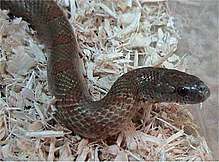Lampropeltis calligaster rhombomaculata
Lampropeltis calligaster rhombomaculata, commonly known as the mole kingsnake or brown kingsnake, is a subspecies of the prairie kingsnake (Lampropeltis calligaster).
| mole kingsnake | |
|---|---|
 | |
| mole kingsnake, Lampropeltis calligaster rhombomaculata | |
| Scientific classification | |
| Kingdom: | Animalia |
| Phylum: | Chordata |
| Class: | Reptilia |
| Order: | Squamata |
| Suborder: | Serpentes |
| Family: | Colubridae |
| Genus: | Lampropeltis |
| Species: | |
| Subspecies: | L. c. rhombomaculata |
| Trinomial name | |
| Lampropeltis calligaster rhombomaculata (Holbrook, 1840) | |
| Synonyms | |
Geographic range
The mole kingsnake is found throughout the southeastern United States and Mid-Atlantic States, but is absent from the Appalachian Mountains.
Description
L. c. rhombomaculata is generally light brown or gray in color, with dark brown, orange, or reddish-brown blotching down the length of its body. They are capable of growing to lengths of 30–40 inches (76.2–101.6 cm). They are easily mistaken for the milk snake and the venomous copperhead, which both share the same type of habitat, and can have similar markings. Some specimens have their markings faded, to appear almost a solid brown color. Juveniles are generally more vivid in markings and coloration. They have small reddish-colored markings on the head.
Behavior
Mole kingsnakes' preferred habitat is open fields with loose, dry soil, typically on the edge of a forested region. Their diet consists primarily of rodents, but they will also consume lizards, frogs and occasionally other snakes. They are nonvenomous, and typically docile. Like most colubrids, if harassed they will vibrate their tail rapidly. These snakes are very secretive and very fossorial and rarely seen above ground during the day unless they are forced out by heavy rains. Mole kingsnakes are mainly nocturnal and commonly seen on paved roads at night.
Reproduction
Male and female mole kingsnakes mate around May–June during late spring to early summer.[2] Females leave behind pheromone trails for males to sense through their forked tongues. After mating, females choose their nesting sites underground or in rotting logs and leave their 10-12 eggs to hatch in the summer. The mother does not stay behind to nurture her offspring, usually leaving right after she laid the eggs. It takes about ten days for the hatched snakes to be fully independent.[3]
References
- The Reptile Database. www.reptile-database.org.
- "Mole Kingsnake - The Maryland Zoo in Baltimore". The Maryland Zoo in Baltimore. Retrieved 2017-05-02.
- "Kingsnake | San Diego Zoo Animals & Plants". animals.sandiegozoo.org. Retrieved 2017-05-02.